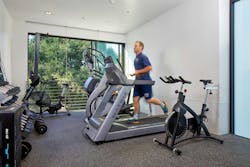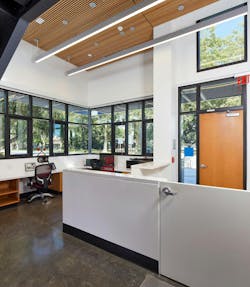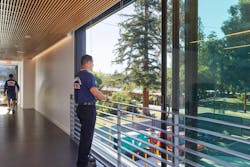Fire Stations and the Firefighter Life Safety Initiatives
“The fire service is 200+ years of tradition, unimpeded by progress.” is a common saying among old firefighters, and if I had a nickel every time I’ve heard those words in my 38 years in fire media, I’d be rich.
However, that quote lost meaning by 2004 when the 16 Firefighter Life Safety Initiatives were created in Tampa, FL. I admit I was skeptical about the fire service changing with the Initiatives, but progress was made and overwhelmed all but the ceremonial fire service traditions.
This year is the 10th anniversary of the Firehouse Station Design Conference. The past 10 years have brought the design of fire stations closer aligned with several of the Life Safety Initiatives. In particular, Cultural Change, Accountability, Medical & Fitness, Research Agenda, Technology, Psychological Support, Code Enforcement & Sprinklers and Apparatus Design & Safety.
Many of these initiatives are intermingled; Life Safety Initiative #1 Cultural Change and #6 Medical & Physical Fitness involve diversity and preventative health in the fire department. New fire station designs started with separate changing rooms and shower facilities for men and women. The most recent trend is individual, non-gender bathrooms, and one-person sleeping rooms with windows. Women using the bathroom off the battalion chief’s office or in the station’s lobby restroom is no longer acceptable.
Mental and physical health
The focus on firefighter health in the station is seen today in every annual Station Design Award entry received. Among other trends, is to address firefighters’ mental health including more natural light with windows in sleeping, eating and living areas. Large windows in fitness rooms offer safety checks for those working out. Some workout rooms have garage doors opening to the outside to improve the atmosphere. In addition to workout machines, reinforced floors for kettlebells, an area for yoga and even pickleball outside (NOT in the apparatus bay) have been added. Pictures of natural scenes have replaced memorable fire incidents or other action photos.
Life Safety Initiative #7, Research Agenda, brought several changes to the designs in the safety of fire stations. Recognizing the incidence of cancer in firefighters, in 2010, NIOSH researchers, with funding assistance from the U.S. Fire Administration launched a multi-year study to examine whether firefighters have a higher risk of cancer and other causes of death due to job exposures.
The University of Arizona Professor Kelly Reynolds MSPH, PhD, and Tucson’s Deputy Chief Ed Nied in 2010 were the first to introduce firefighter exposure to unhealthy furnishings in fire stations. During a conference in Phoenix, they shared pictures of microscopic green mold found covering the couch, recliners, and carpets in the living area of one station. Over time, anti-bacterial material for furniture and removal of carpets in fire stations became the standard.
Erickson leads the way
Research on firefighter health made a significant change in 2014 at the first Firehouse Station Design Conference when Paul Erickson, formerly with LeMay Erickson Willcox Architects, introduced the Hot Zone Design concept. The Hot Zone plan divided the station into red, yellow and green zones. Firefighters returning from an active incident with turnout gear covered with cancer-causing carcinogens would enter the red zone’s decontamination process. After removing gear, showering and changing clothes, they move through the yellow transition zone and enter the green zone living area.
Life Safety Initiative #13, Psychological Support, recommends research on PTSD and stress and firefighter depression, addictions and suicides. Paul Erickson continued his research into medical facilities designs to address the mental health of medical staff. In subsequent presentations, Erickson introduced conducive lighting, access to natural greenery, alcoves or quiet areas and room colors geared to help de-stress in fire stations.
During the 2024 Station Design Conference, Paul Erickson’s impact on firefighter health in fire stations will be recognized with an award for his decade of support for firefighters and first responders' physical and mental health.
Life Safety Initiative #15, Code Enforcement & Sprinklers, requires fire sprinklers in fire stations. The Station Design Awards portfolio asks if fire sprinklers are in the station and today, very few reply “No!” Departments need to lead by example regarding commercial and residential sprinklers. Very few new stations are non-sprinklered.
Literally and figuratively ventilated
The last Life Safety Initiative, #16 Fire Design & Safety, reads: Safety must be a primary consideration in the design of apparatus and equipment.
Apparatus and emergency vehicles in apparatus bays and maintenance areas are risky because of exposure to apparatus exhaust and other chemicals. The apparatus bay is an integral first step of Hot Zone Design’s decontamination procedures for firefighters returning from an incident.
Trusted ventilation systems are required, and many stations now have two types of air extraction systems.
The old quote about “unimpeded by progress” is retired. Progress in the fire service is continuous and many members of the fire service and dedicated service providers and manufacturers have and will continue to progress in the fire service.
About the Author
Janet A. Wilmoth
Special Projects Director
Janet Wilmoth grew up in a family of firefighters in a suburb of Chicago. Wilmoth, who is owner of Wilmoth Associates, worked with Fire Chief magazine for 27 years until it closed in 2013. She currently is the project director for Firehouse, overseeing the Station Design Conference.



